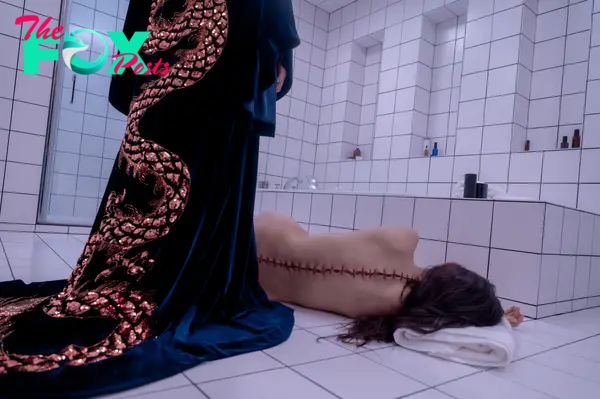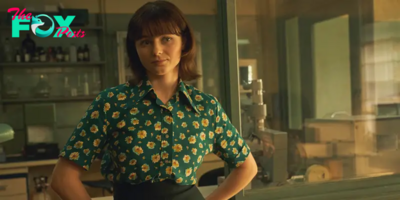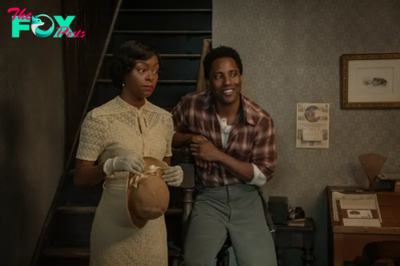Entertainment
The Substance Viscerally Captures the Frustration of Being an Aging Woman—Until It Spins Out of Control
The big word-of-mouth hit around the 76th Cannes Film Festival is a French horror movie, in English and featuring American stars, about an aging, increasingly insecure actress, Demi Moore’s Elizabeth Sparkle, who has the chance to morph into a younger, “better” version of herself—with a catch, of course. That movie is The Substance, and though not everyone loves it, in a place where critics and industry professionals are loading roughly three to six films per day into their brains, a picture that people keep talking about constitutes a success. The director, Coralie Fargeat, has made one previous feature (2017’s bloody payback thriller Revenge), and she’s 48 years old—old enough to know what it’s like to reach that age when your sexual allure may be draining away. There are plenty of body horror movies out there, and quite a few made by women. (Julia Ducorneau’s allegedly shocking but really just dumb 2021 Palme d’Or winner Titane is only one recent example.) But The Substance is distinctive less for its nutso, over-the-top gore than for a single scene midway through the film that exposes a different kind of body horror—or, more specifically, the way insecurity can be its own kind of horror.
There are people who prefer to go into every horror film cold—you know who you are—but there’s no way to discuss The Substance without unraveling some key details, so make that decision for yourself right now. Moore’s Elizabeth is a formerly beloved movie star who’s now doing OK with her own 1980s-style exercise show, during which she leads a bevy of beauties in reasonably tasteful workout wear through a sweaty routine of stretching and jumping. Elizabeth looks great, but even though it’s not said aloud, you can hear the whispery tail end of that compliment, a bitter scorpion’s sting: “for her age.” Elizabeth has gotten an inkling her that her boss, a wrinkled creep who wears flashy suits and chews with his mouth open—he’s played by Dennis Quaid, clearly having a ball as he leans into the character's grotesquerie—is looking to replace her. Then she catches wind of an underground rejuvenation regime called The Substance. A random acquaintance turns her onto it surreptitiously, slipping her a scrawled note that reads: "It changed my life."
At first Elizabeth resists; then desperation drives her to go for it. The treatment involves injecting an activator, which stimulates the creation of a younger, and supposedly in all ways better, clone. After that, the original and the clone must switch roles every seven days, without exception, via some sort of mystery transfusion. The persona who’s in use on any given week gets to go out and about in the world; the other lies in a grim coma at home, kept alive by the seven-day supply of food—or something—being pumped into her. The instructions that come with the kit blare a warning: the user mustn't forget that the two versions are one.
Read more: The 100 Best Movies of the Past 10 Decades

It turns out that Elizabeth’s younger self, played with perfect, glitter-tinged vapidness by Margaret Qualley, becomes Elizabeth’s replacement on the exercise show, which becomes a crazy symphony of wriggling butts in shiny Spandex. Fargeat revels in the peachiness of these butts—they become a running gag in the movie, though of course, they also simply invite our ogling pleasure in the basest way. But that, too, is part of the breezy boldness of Fargeat’s approach. She may be asking all of us—man, woman, or nonbinary—isn’t it OK just to take pleasure in looking, especially at beautiful young people? Or does it automatically count as exploitation, the sort of thing we’re supposed to disapprove of, in our culture full of strict no-nos? The Substance is also brazen in its flaunting of female nudity. Through the ’90s and into the early 2000s, nudity in American movies was so common as to seem unexceptional. Yet it has practically disappeared. Much of that can be chalked up to actresses' feeling more empowered to say No if they’d rather not do it.
That’s a step forward in terms of safety for young performers, but it might be a step backward for art. The absence of nudity in modern movies has only served to attach a sense of shame to it. But Fargeat seems to recognize that one of the pleasures of movies is looking at beautiful people, clothed or not. She lights her two lead actors in a way that’s respectful but not fussy. (The whole movie has a stylized, lip-glossy look, like a Patrick Nagel painting come to life.) Moore and Qualley may be naked, yet they don’t seem unduly exposed. They’re sexy, maybe, but there’s a classical quality about them too—they’re a little Crazy Horse, a little Manet “Picnic on the Grass.” The point, maybe, is that it doesn’t matter so much whether there’s a man or woman behind the camera; there are a million ways of gazing, for all of us.
Here's the bad news about The Substance: the ending, the gonzo bloodfest and body-horror extravaganza that has been praised to the skies by lots of critics, is actually the lamest thing about it. It goes on for too long, not so much blasting past the limits of good taste as grinding away at achieving bad taste. Though this dragged-out finale does include a Vertigo reference that’s a great little inside joke, it lumbers on far too long. The gross-outs in the middle of the movie are much more effective than anything at the end. It seems that Fargeat didn’t know how to round out her ideas at the finish, so she simply threw as much on the screen as she could.
So let's forget the ending of The Substance and go back to its much better middle. Once, when I was around 50, my beautiful older sister, then in her early 60s, happened to start telling me about her experience of menopause, during and after. I thought I already knew it all; there’s plenty of information out there, about choices we can make or even just how to endure hot flashes. But nowhere had I read the exact thing she wanted to talk about. It began with the classic, and expected, “Men—even men much older than you are—stop looking at you.” But she went on to describe her experience in an even more specific way: “It’s like they can sense that some light has gone out of you, and they’re not interested. To them, your ability to make a baby is the thing that makes you viable and alive and desirable, even if the last thing they want is to make a baby. That’s why they won't look at you, at least in terms of how we comport ourselves in the outside world, just walking around on the street, interacting with one another.” I’m paraphrasing, but that was the idea. And the look in her eyes told me that this was one of the hardest things for her. Menopause and the years following mean a string of goodbyes, some of them easier to say than others.

Don’t get me wrong—the benefits of coming through the whole damn thing can be amazing. But the adjustments you have to make along the way, even if you talk about them with your friends, are still so interior and so personal that they can make you feel like the deepest well of loneliness. This is exactly what The Substance captures in its greatest scene, somewhere in the film's middle, a sequence that Moore pulls off magnificently. Elizabeth, who has to spend her seven days being her regular fifty-something self, has come to resent her younger counterpart, who's having all the fun after shooting to fame as a TV personality named Sue. In a moment of desperation, she sets up a date with a sweet but nerdy high-school classmate who had recently asked her for a date. She’s politely taken his number, with no intention of calling. But in her loneliness, in her moments of needing to remind herself that she still has something to offer the world, she starts to think, Hey, he did seem pretty nice. She calls him and sets up a date; he’s surprised but delighted. She puts on an amazing going-out dress, a low-cut (but not too low-cut) red minidress; she can still wear skyscraper heels, and when she slips into them, she's as tall as an Amazon. She puts on just the right amount of makeup—she knows all the tricks that work. She looks in the mirror and loves what she sees—we do too.
Then she catches sight of a giant billboard featuring Sue’s ultra-flexible body and dewy complexion, which happens to be unavoidably right outside the window of her spare-chic high-rise apartment. She also peeks in on Sue’s sleeping form, which is having its seven-day tube-fed rest. Then she looks in the mirror again and this time hates what she sees; comparison is the great ego killer. She adds pinkier blush; she tops her lips with goopy gloss. Then she really hates how she looks, and smears everything to start again, only to create a monstrously exaggerated version of her original, just-right look. She wraps a scarf around her décolletage, suddenly feeling she’s showing off too much. She wastes so much time adding coverups and various forms of subterfuge that she never leaves for the date.
I didn’t know whether to laugh or cry as I watched this scene, so I did a little of both. I said to the friend next to me, “I didn’t know this was a documentary,” and we laughed again. The Substance eventually fell apart for me, and though this is hardly the movie’s fault, I’m already bored by the stock interpretation attached to it: “This is a film about how society pressures women to feel terrible about aging, especially in show Business.” Of course, yes, it’s that. It’s also about age discrimination in any job, and that’s a very real thing. But at its best, The Substance is also about something much more subterranean, that string of just-past-midlife goodbyes that are really hard to make. It seems that Fargeat, into middle age herself, is already reckoning with some of them, and she’s turned them into a brilliant, bitter joke. It hurts to laugh—until it doesn't.
-

 Entertainment1h ago
Entertainment1h agoRHOBH’s Mauricio Umansky Replaced a Photo of Kyle Richards on His Desk With One of DWTS’ Emma Slater
-

 Entertainment3h ago
Entertainment3h agoAmerica On CoffeeWe’re simply inviting you to take a timeout into the rhythmic ambiance of our breakfast, brunch and/or espresso picks. We’re completely satisfied everytime you cease by.Creole Espresso Recipes
-

 Entertainment3h ago
Entertainment3h agoThe Best Internet Memes About Elon Musk’s Tesla Robot
-

 Entertainment9h ago
Entertainment9h agoAmerica On CoffeeWe’re simply inviting you to take a timeout into the rhythmic ambiance of our breakfast, brunch and/or espresso picks. We’re pleased everytime you cease by.“BLONDIE – RAPTURE”
-

 Entertainment9h ago
Entertainment9h agoGladiator 3 Already in Works, Reveals Director
-

 Entertainment14h ago
Entertainment14h agoAmerica On CoffeeWe’re simply inviting you to take a timeout into the rhythmic ambiance of our breakfast, brunch and/or espresso picks. We’re comfortable everytime you cease by.Take pleasure in And, Chill out …
-

 Entertainment14h ago
Entertainment14h agoHow ‘Interior Chinatown’ Satirises Asians in Hollywood with Witty Social Commentary
-

 Entertainment19h ago
Entertainment19h agoPHOTO GALLERY: The Seaside Boys – OLG Stage at Fallsview On line casino – Niagara Falls, Ontario – November 16, 2024



























